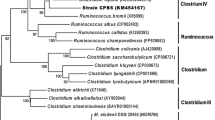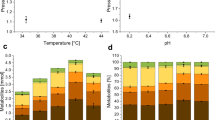Abstract
Following incubation of mesophilic methanogenic floccular sludge from a lab-scale upflow anaerobic sludge bed reactor used to treat cattle manure wastewater, a stable 5-aminosalicylate-degrading enrichment culture was obtained. Subsequently, a Citrobacter freundii strain, WA1, was isolated from the 5-aminosalicylate-degrading methanogenic consortium. The methanogenic enrichment culture degraded 5-aminosalicylate completely to CH4, CO2 and NH4 +, while C. freundii strain WA1 reduced 5-aminosalicylate with simultaneous deamination to 2-hydroxybenzyl alcohol during anaerobic growth with electron donors such as pyruvate, glucose or serine. When grown on pyruvate, C. freundii WA1 converted 3-aminobenzoate to benzyl alcohol and also reduced benzaldehyde to benzyl alcohol. Pyruvate was fermented to acetate, CO2, H2 and small amounts of lactate, succinate and formate. Less lactate (30%) was produced from pyruvate when C. freundii WA1 grew with 5-aminosalicylate as co-substrate.





Similar content being viewed by others
References
Bock M, Kneifel H, Schoberth SM, Sahm H (2000) Reduction of halogenated derivatives of benzoic acid to the corresponding alcohols by Desulfovibrio vulgaris PY1. Acta Biotechnol 20:189–201
Braun K, Gibson DT (1984) Anaerobic degradation of 2-aminobenzoate (anthranilic acid) by denitrifying bacteria. Appl Environ Microbiol 48:102–107
Cartwright NJ, Cain RB (1959) Bacterial degradation of the nitrobenzoic acids. 2. Reduction of the nitro group. Biochem J 73:305–314
Doetsch RN (1981) Determinative methods of light microscopy. In: Gerhardt P, Murray RGE, Costilow RN, Nester EW, Wood WA, Krieg NR, Phillips GB (eds) Manual of methods for general bacteriology. American Society of Microbiology, Washington, DC, pp 21–33
Edwards U, Rogall T, Bloecker H, Emde MD, Boettger EC (1989) Isolation and direct complete nucleotide determination of entire genes, characterization of gene coding for 16S ribosomal RNA. Nucleic Acids Res 17:7843–7853
Fawcett JK, Scott JE (1960) A rapid and precise method for the determination of urea. J Clin Path 13:156–159
Fraisse L, Simon H (1988) Observations on the reduction of non-activated carboxylates by Clostridium formicoaceticum with carbon monoxide or formate and the influence of various viologens. Arch Microbiol 150:381–386
Genthener BRS, Townsend GT, Blattmann BO (1997) Reduction of 3-chlorobenzoate, 3-bromobenzoate, and benzoate to corresponding alcohols by Desulfomicrobium escambiense, isolated from a 3-chlorobenzoate-dechlorinating coculture. Appl Environ Microbiol 63:4698–4703
Haderlein SB, Schwarzenbach RP (1995) Environmental processes influencing the rate of abiotic reduction of nitroaromatic compounds in the subsurface. In: Spain JC (ed) Biodegradation of nitroaromatic compounds, vol 49. Plenum, New York, pp 199–225
Heider J, Fuchs G (1997) Anaerobic metabolism of aromatic compounds. Eur J Biochem 243:577–596
Jensen J, Cornett C, Olsen CE, Tjornelund J, Hansen SH (1992) Identification of major degradation products of 5-aminosalicylic acid formed in aqueous solutions and in pharmaceuticals. Int J Pharm 88:177–187
Kalyuzhnyi S, Sklyar V (2000) Biomineralisation of azo dyes and their breakown products in anaerobic-aerobic hybrid and UASB reactors. Water Sci Technol 41:23–30
Kalyuzhnyi S, Sklyar V, Mosolova T, Kucherenko I, Russkova J, Degtyaryova N (2000) Methanogenic biodegradation of aromatic amines. Water Sci Technol 42:363–370
Marmur J (1961) The procedure for the isolation of DNA from microorganisms. J Molec Biol 3:208–218
Razo-Flores E, Donlon B, Field J, Lettinga G (1996) Biodegradability of N-substituted aromatics and alkylphenols under methanogenic conditions using granular sludge. Water Sci Technol 33:47–57
Razo-Flores E, Luijten M, Donlon B, Lettinga G, Field JA (1997) Complete biodegradation of the azo dye azodisalicylate under anaerobic conditions. Environ Sci Technol 31:2098–2103
Razo-Flores E, Lettinga G, Field JA (1999) Biotransformation and biodegradation of selected nitroaromatics under anaerobic conditions. Biotechnol Prog 15:358–365
Schnell S, Schink B (1992) Anaerobic degradation of 3-ABA by a newly isolated sulfate reducer and a methanogenic enrichment culture. Arch Microbiol 158:328–334
Simon H, White H, Lebertz H, Thanos J (1987) Reduktion von 2-Enoaten und Alkanoaten mit Kohlenmonoxid oder Formiat, Violognen und Clostridium thermoaceticum zu gesättigten Säuren und ungesättigten bzw. gesättigten Alkoholen. Angew Chem 99:785–787
Smibert RM, Krieg NR (1981) General characterization. In: Gerhardt P, Murray RGE, Costilow RN, Nester EW, Wood WA, Krieg NR, Phillips GB (eds) Manual of methods for general bacteriology. American Society of Microbiology, Washington, DC, pp 409–444
Stackebrandt E, Goebel BM (1994) Taxonomic note: a place for DNA-DNA reassociation and 16S rRNA sequence analysis in the present species definition in bacteriology. Int J Syst Bacteriol 44:846–849
Stams AJM, van Dijk JB, Dijkema C, Plugge CM (1993) Growth of syntrophic propionate-oxidizing bacteria with fumarate in the absence of methanogenic bacteria. Appl Environ Microbiol 59:1114–1119
Thompson, JD, Higgins, DG, Gibson, TJ (1994) CLUSTAL W: improving the sensitivity of progressive multiple sequence alignment through sequence weighting, positions-specific gap penalties and weight matrix choice. Nucleic Acids Res 22:4673–4680
Tschech A, Fuchs G (1987) Anaerobic degradation of phenol by pure cultures of newly isolated denitrifying pseudomonads. Arch Microbiol 148:213–217
Van de Peer Y, De Wachter R (1994) TREECON for Windows: a software package for the construction and drawing of evolutionary trees for the Microsoft Windows environment. Comput Applic Biosci 10:569–570
Van den Ban ECD, Willemen HN, Wassink H, Laane C, Haaker H (1999) Bioreduction of carboxylic acids by Pyrococcus furiosus in batch cultures. Enzyme Microb Technol 25:251–257
Walker R (1970) The metabolism of azo compounds: a review of the literature. Food Cosmetic Toxicol 8:659–676
Weber EJ, Wolfe LN (1987) Kinetic studies of the reduction of aromatic azo compounds in anaerobic sediment/water systems. Environ Toxicol Chem 6:911–919
Acknowledgements
We thank S. Parshina and V. Sklyar for stimulating discussions. This research was supported by the graduate school WIMEK and by RFBR grant no. 01-04-49601.
Author information
Authors and Affiliations
Corresponding author
Rights and permissions
About this article
Cite this article
Savelieva, O., Kotova, I., Roelofsen, W. et al. Utilization of aminoaromatic acids by a methanogenic enrichment culture and by a novel Citrobacter freundii strain. Arch Microbiol 181, 163–170 (2004). https://doi.org/10.1007/s00203-003-0645-1
Received:
Revised:
Accepted:
Published:
Issue Date:
DOI: https://doi.org/10.1007/s00203-003-0645-1




